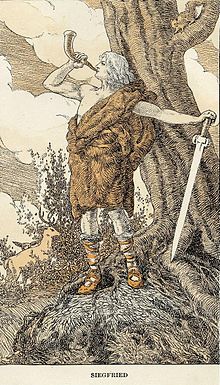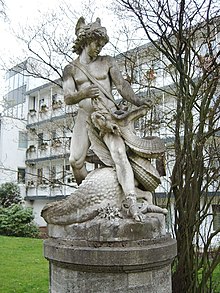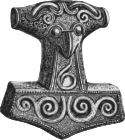
| Home | Sources Directory | News Releases | Calendar | Articles | | Contact | |
Sigurd
This file is a candidate for speedy deletion. It may be deleted after seven days from the date of nomination.


Sigurd (Old Norse: Sigurðr) is a legendary hero of Norse mythology, as well as the central character in the Völsunga saga. The earliest extant representations for his legend come in pictorial form from seven runestones in Sweden[1] and most notably the Ramsund carving (c. 1000) and the Gök Runestone (11th century).
As Siegfried, he is the hero in the German Nibelungenlied, and Richard Wagner's operas Siegfried and Götterdämmerung.
As Sivard Snarensven(d) he was the hero of several medieval Scandinavian ballads.
The name Sigurðr is not the same name as the German Siegfried. The Old Norse form would have been Sigruþr, a form which appears in the Ramsund carving that depicts the legend.[2] Sivard is another variant name of Sigurðr; these name forms all share the first element Sig-, which means victory.
Contents |
[edit] Völsunga saga
In the Völsunga saga, Sigurd is the posthumous son of Sigmund and his second wife, Hiordis. Sigmund dies in battle when he attacks Odin (who is in disguise), and Odin shatters Sigmund's sword. Dying, Sigmund tells Hiordis of her pregnancy and bequeaths the fragments of his sword to his unborn son.
Hiordis marries King Alf, and then Alf decided to send Sigurd to Regin as a foster. Regin tempts Sigurd to greed and violence by first asking Sigurd if he has control over Sigmund's gold. When Sigurd says that Alf and his family control the gold and will give him anything he desires, Regin asks Sigurd why he consents to a lowly position at court. Sigurd replies that he is treated as an equal by the kings and can get anything he desires. Then Regin asks Sigurd why he acts as stableboy to the kings and has no horse of his own. Sigurd then goes to get a horse. An old man (Odin in disguise) advises Sigurd on choice of horse, and in this way Sigurd gets Grani, a horse derived from Odin's own Sleipnir.
Finally, Regin tries to tempt Sigurd by telling him the story of the Otter's Gold. Regin's father was Hreidmar, and his two brothers were Ótr and Fafnir. Regin was a natural at smithing, and Ótr was natural at swimming. Ótr used to swim at Andvari's waterfall, where the dwarf Andvari lived. Andvari often assumed the form of a pike and swam in the pool.
One day, the Æsir saw Ótr with a fish on the banks, thought him an otter, and Loki killed him. They took the carcass to the nearby home of Hreidmar to display their catch. Hreidmar, Fafnir, and Regin seized the Æsir and demanded compensation for the death of Ótr. The compensation was to stuff the body with gold and cover the skin with fine treasures. Loki got the net from the sea giantess R�¡n, caught Andvari (as a pike), and demanded all of the dwarf's gold. Andvari gave the gold, except for a ring. Loki took this ring, too, although it carried a curse of death on its bearer. The Æsir used this gold and stuffed Ótr's body with gold and covered its skin in gold and covered the last exposed place (a whisker) with the ring of Andvari. Afterward, Fafnir killed Hreidmar and took the gold.
Sigurd agrees to kill Fafnir, who has turned himself into a dragon in order to be better able to guard the gold. Sigurd has Regin make him a sword, which he tests by striking the anvil. The sword shatters, so he has Regin make another. This also shatters. Finally, Sigurd has Regin make a sword out of the fragments that had been left to him by Sigmund. The resulting sword, Gram, cuts through the anvil. To kill Fafnir the dragon, Regin advises him to dig a pit, wait for Fafnir to walk over it, and then stab the dragon. Odin, posing as an old man, advises Sigurd to dig trenches also to drain the blood, and to bathe in it after killing the dragon; bathing in Fafnir's blood confers invulnerability. Sigurd does so and kills Fafnir; Sigurd then bathes in the dragon's blood, which touches all of his body except for one of his shoulders where a leaf was stuck. Regin then asked Sigurd to give him Fafnir's heart for himself. Sigurd drinks some of Fafnir's blood and gains the ability to understand the language of birds. Birds advise him to kill Regin, since Regin is plotting Sigurd's death. Sigurd beheads Regin, roasts Fafnir's heart and consumes part of it. This gives him the gift of "wisdom" (prophecy).
Sigurd met Brynhildr, a "shieldmaiden," after killing Fafnir. She pledges herself to him but also prophesies his doom and marriage to another. (In Völsunga saga, it is not clear that Brynhild is a Valkyrie or in any way supernatural.)
Sigurd went to the court of Heimar, who was married to Bekkhild, sister of Brynhild, and then to the court of Gjúki, where he came to live. Gjuki had three sons and one daughter by his wife, Grimhild. The sons were Gunnar, Hogni and Guttorm, and the daughter was Gudrun. Grimhild made an "Ale of Forgetfulness" to force Sigurd to forget Brynhild, so he could marry Gudrun. Later, Gunnar wanted to court Brynhild. Brynhild's bower was surrounded by flames, and she promised herself only to the man daring enough to go through them. Only Grani, Sigurd's horse, would do it, and only with Sigurd on it. Sigurd exchanged shapes with Gunnar, rode through the flames, and won Brynhild for Gunnar.
Some time later, Brynhild taunted Gudrun for having a better husband, and Gudrun explained all that had passed to Brynhild and explained the deception. For having been deceived and cheated of the husband she had desired, Brynhild plots revenge. First, she refuses to speak to anyone and withdraws. Eventually, Sigurd was sent by Gunnar to see what was wrong, and Brynhild accuses Sigurd of taking liberties with her. Gunnar and Hogni plot Sigurd's death and enchant their brother, Guttorm, to a frenzy to accomplish the deed. Guttorm kills Sigurd in bed, and Brynhild kills Sigurd's three year old son Sigmund (named for Sigurd's father). Brynhild then wills herself to die, and builds a funeral pyre for Sigurd, Sigurd's son, Guttorm (killed by Sigurd) and herself. Sigurd and Brynhild had the daughter Aslaug who married Ragnar Lodbrok.
Sigurd and Gudrun are parents to the twins Sigmund (named after Sigurd's father) and Svanhild.
[edit] By Thidrekssaga
The Old Norse Thidrekssaga (chapters 152-168) relates a slightly different tale, with Regin as the dragon and Mimir as Regin's brother and foster-father to Sigurd. In this version, King Sigmund returns home from travel and hears that his wife Sisibe has been accused of illicit relations with a thrall. Although the accusation is a lie told by two of his noblemen whose lustful advances Sisibe rejected, Sigmund believes it and orders the noblemen to take her into the forest and kill her. One is moved by pity for her, and the two fight. As they fight, Sisibe gives birth to a child (Sigmund's) and places it in a crystal vessel, which is kicked into a river and travels downstream. Sisibe dies; the vessel is found by a doe, which nurses the infant. Later, the young child is found by a wise smith of the forest, Mimir who names him Sigurd (although a few times the saga calls him Sigfred) and takes him as his own. When the child grows large and willful, Mimir asks his brother, Regin, a dragon, to kill Sigurd. But Sigurd slays the dragon and then kills his disloyal foster-father.[3][4]
In chapters 225-230, Sigurd marries Gunnar's sister Grimhild, despite having promised to marry Brynhild. Later, Gunnar marries Brynhild, but she resists his attempts to consummate the marriage because she loves only Sigurd. As a favor to his brother-in-law, Sigurd sleeps with Brynhild, who is thereafter unable to resist Gunnar, as her strength came from her virginity.[5][6]
[edit] Archaeological record
The Ramsund carving depicts
- how Sigurd is sitting naked in front of the fire preparing the dragon heart, from Fafnir, for his foster-father Regin, who is Fafnir's brother. The heart is not yet fully roasted, and when Sigurd touches it, he burns himself and sticks his finger into his mouth. As he has tasted dragon blood (some blood was on the heart), he starts to understand the birds' song.
- The birds say that Regin will not keep his promise of reconciliation and will try to kill Sigurd, which causes Sigurd to cut off Regin's head.
- Regin is dead beside his own head, his smithing tools with which he reforged Sigurd's sword Gram are scattered around him, and
- Regin's horse is laden with the dragon's treasure.
- is the previous event when Sigurd killed Fafnir, and
- Ótr from the saga's beginning.
Other aspects of the legend are shown on the various Sigurd stones.
[edit] Parallels in other legends
There are parallels in several European myths and legends.
The sword Sigmund draws from Barnstock is similar to the sword drawn by King Arthur from the stone.
The story of Sigurd eating the heart of the dragon is very similar to the Irish story of Fionn mac Cumhail eating the Salmon of Wisdom he had been preparing for his mentor, Finn Eces.
Sigurd's invulnerability and his weak point (in the Nibelungenlied) are similar to those of the Greek hero Achilles, the Persian hero Esfandyar, and the Duryodhana story of India's Mahabharata epic.
[edit] Cultural impact
Because dragons were seen as symbols of Satan in medieval typologies, the story of Sigurd slaying Fafnir was often depicted in Christian churches in Scandinavia.
[edit] Adaptations of the legend

- The best-known adaptation of the Sigurd legend is Richard Wagner's cycle of music dramas Der Ring des Nibelungen (written between 1848 and 1874). The Sigurd legend is the basis of Siegfried and contributes the stories of Die Walküre and Götterdämmerung.
- William Morris's epic poem Sigurd the Volsung (1870) is a major retelling of the story in English verse.
- In 1884 the French composer Ernest Reyer wrote the lesser-known opera Sigurd, which has the benefit of condensing the story into one evening, with equally stirring music.
- The illustrator Arthur Rackham drew 70 vibrant renderings of the story for the book Siegfried & The Twilight of the Gods, translated by Margaret Armour (1910).
- Arthur Peterson published a translation of the myth of Sigurd titled Andvari's Ring, in 1916.
- Fritz Lang and his then-wife Thea von Harbou adapted the story of Sigurd (called Siegfried) for the first part of their 1924 pair of silent films Die Nibelungen.
- This legend was also adapted into a movie, Ring of the Nibelungs (2004).
- Fantasy author Diana L. Paxson retold the story in her trilogy Wodan's Children: The Wolf and the Raven (1993), The Dragons of the Rhine (1995), and The Lord of Horses (1996).
- Stephan Grundy retold the story in his novel Rhinegold (1995).
- The Faroese viking/ folk metal band Týr, has a song named "Regin Smiður", which is based on the a Faroese kvæði in three parts, Sjúrðarkvæðið, which chronicles the life of Sigurd (Faroese: Sjúrður).
- An adaptation of the legend written in verse by Oxford philology professor and fantasy author J.R.R. Tolkien, The Legend of Sigurd and Gudrún, was released in May, 2009.
- In the Soul Calibur series, a character named Siegfried Schtauffen is the main protagonist of the games. The sword Gram (mistranslated as "Glam") is one of his many selectible weapons.
- Dark Kingdom: The Dragon King (2006) SyFy miniseries.
- The Japanese animated series Saint Seiya presented an arc based on Norse mythology. The main character, Seiya, must fight against Siegfried, a knight whose background story is very similar to that of Sigurd'He killed the dragon Fafnir with a spear, but he did not eat his heart, instead, he was completely showered by its blood making him essentially immortal, except for a spot in his back, which was covered by a leaf, making it his only weak point. This arc was not present in the Manga version of Saint Seiya.
- Sigurd is a recurring character in various songs of the album Buch der Balladen by the German pagan folk band Faun.
[edit] Notes
- ^ An article at the Museum of Foteviken, Sweden, retrieved January 19, 2007.
- ^ Brate, E. (1922). Sveriges runinskrifter. p. 126.
- ^ Rank, Otto. The Myth of the Birth of the Hero. New York: Vintage, 1932, pp. 56-59. Haymes, Edward R., trans. The Saga of Thidrek of Bern. New York: Garland, 1988.
- ^ summary of the Thiðrekssaga at Timeless Myths
- ^ Two marriage episodes from The Saga of Thidrek of Bern, retrieved April 19, 2009.
- ^ summary of the Thiðrekssaga at Timeless Myths
[edit] See also
| Wikimedia Commons has media related to: Siegfried |
|
|||||||||||||||||||
|
|||||||||||||||||||||||||||||||||
|
SOURCES.COM is an online portal and directory for journalists, news media, researchers and anyone seeking experts, spokespersons, and reliable information resources. Use SOURCES.COM to find experts, media contacts, news releases, background information, scientists, officials, speakers, newsmakers, spokespeople, talk show guests, story ideas, research studies, databases, universities, associations and NGOs, businesses, government spokespeople. Indexing and search applications by Ulli Diemer and Chris DeFreitas.
For information about being included in SOURCES as a expert or spokesperson see the FAQ or use the online membership form. Check here for information about becoming an affiliate. For partnerships, content and applications, and domain name opportunities contact us.




